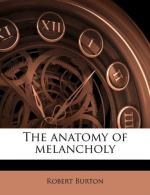to take leave of her sweetheart now going to wars,
ut desiderio ejus minus tabesceret, to comfort
herself in his absence, she took his picture with
coal upon a wall, as the candle gave the shadow, which
her father admiring, perfected afterwards, and it
was the first picture by report that ever was made.
And long after, Sycion for painting, carving, statuary,
music, and philosophy, was preferred before all the
cities in Greece. [5541]Apollo was the first inventor
of physic, divination, oracles; Minerva found out
weaving, Vulcan curious ironwork, Mercury letters,
but who prompted all this into their heads? Love,
Nunquam talia invenissent, nisi talia adamassent,
they loved such things, or some party, for whose sake
they were undertaken at first. ’Tis true,
Vulcan made a most admirable brooch or necklace, which
long after Axion and Temenus, Phegius’ sons,
for the singular worth of it, consecrated to Apollo
at Delphos, but Pharyllus the tyrant stole it away,
and presented it to Ariston’s wife, on whom he
miserably doted (Parthenius tells the story out of
Phylarchus); but why did Vulcan make this excellent
Ouch? to give Hermione Cadmus’ wife, whom he
dearly loved. All our tilts and tournaments, orders
of the garter, golden fleece, &c.—Nobilitas
sub amore jacet—owe their beginnings
to love, and many of our histories. By this means,
saith Jovius, they would express their loving minds
to their mistress, and to the beholders. ’Tis
the sole subject almost of poetry, all our invention
tends to it, all our songs, whatever those old Anacreons:
(and therefore Hesiod makes the Muses and Graces still
follow Cupid, and as Plutarch holds, Menander and the
rest of the poets were love’s priests,) all
our Greek and Latin epigrammatists, love writers.
Antony Diogenes the most ancient, whose epitome we
find in Phocius Bibliotheca, Longus Sophista, Eustathius,
Achilles, Tatius, Aristaenetus, Heliodorus, Plato,
Plutarch, Lucian, Parthenius, Theodorus, Prodromus,
Ovid, Catullus, Tibullus, &c. Our new Ariostoes,
Boyards, Authors of Arcadia, Urania, Faerie Queen,
&c. Marullus, Leotichius, Angerianus, Stroza,
Secundus, Capellanus, &c. with the rest of those facete
modern poets, have written in this kind, are but as
so many symptoms of love. Their whole books are
a synopsis or breviary of love, the portuous of love,
legends of lovers’ lives and deaths, and of their
memorable adventures, nay more, quod leguntur,
quod laudantur amori debent, as [5542]Nevisanus
the lawyer holds, “there never was any excellent
poet that invented good fables, or made laudable verses,
which was not in love himself;” had he not taken
a quill from Cupid’s wings, he could never have
written so amorously as he did.
[5543] “Cynthia te vatem fecit lascive Properti,
Ingenium
Galli pulchra Lycoris habet.
Fama
est arguti Nemesis formosa Tibulli,
Lesbia
dictavit docte Catulle tibi.
Non
me Pelignus, nec spernet Mantua vatem,
Si
qua Corinna mihi, si quis Alexis erit.”




